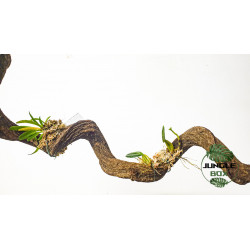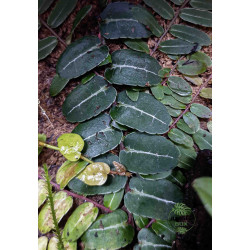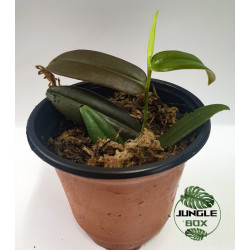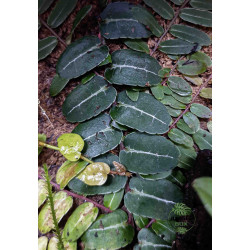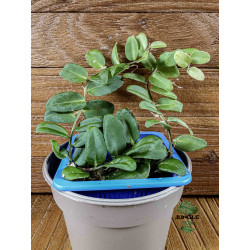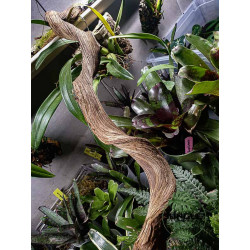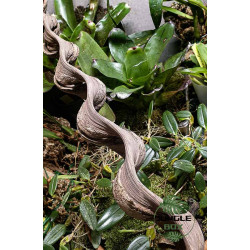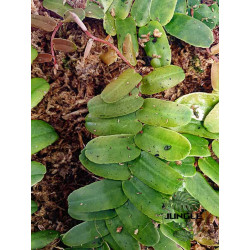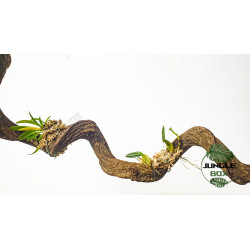Vines
Vines are often used in terrariums due to their attractive appearance and their ability to climb and spread in limited vertical space.
Climbing Growth: Vines are climbing plants that produce adventitious roots, allowing them to attach and climb along the walls of the terrarium.
Decorative Foliage: The leaves of vines are often glossy and colorful, adding a touch of tropical aesthetics to your terrarium.
Need for Support: As climbing plants, they generally require supports such as moss sticks, trellises, or other plants to cling to and grow.
Growing Conditions: Vines typically thrive in medium to bright light conditions and prefer high humidity. They can be grown in various types of substrates, but they generally benefit from a well-draining mix containing sphagnum moss.
Pruning: Make sure to regularly prune your vines to control their growth and prevent them from smothering other plants in the terrarium.
By incorporating vines into your terrarium, you can create a lush and tropical environment for your plants and animals, as well as add vertical dimension to the layout.
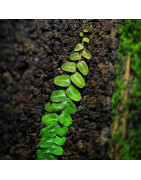
Subcategories
-
jungle vine
If you're using a vine as a decorative element in a terrarium, here are some ideas on how to incorporate it aesthetically:
-
Selecting the Vine: Choose a vine that suits the size of your terrarium and the environment you want to create. Plants like pothos (Scindapsus), philodendron, or hoyas are popular choices because they are sturdy, easy to maintain, and have attractive foliage.
-
Strategic Placement: Use the vine to fill the vertical space of the terrarium. Place it near the walls or wrap it around branches or supports to create a lush jungle effect.
-
Creating Layers: Vines can be arranged at different levels in the terrarium to add visual depth. Let them cascade down the walls or climb on wooden or metal structures.
-
Combining with Other Plants: Pair the vine with other terrarium-appropriate plants to create a balanced mini-ecosystem. Ferns, bromeliads, and miniature orchids are excellent choices to accompany vines.
-
Using Natural Supports: Incorporate branches, pieces of wood, or roots into the terrarium to serve as supports for the vine. This will add a natural and realistic aspect to your décor.
-
Regular Maintenance: Trim the vine as needed to control its growth and maintain an attractive shape. Make sure the vine doesn't become invasive or smother other plants in the terrarium.
-
Lighting and Humidity: Ensure the vine receives the appropriate amount of light according to its specific needs. Also, maintain adequate humidity in the terrarium by regularly misting the leaves.
-
Creativity in Arrangement: Explore different ways to arrange the vine in the terrarium. You can have it climb up a wall to create a cascading effect or wrap it around rocks for a more organic look.
By using a vine as a decorative element in your terrarium, you can create a captivating miniature environment reminiscent of the beauty and diversity of tropical jungles. Have fun experimenting with different arrangements and compositions to achieve the desired look.
-
-
Marcgravia vine
Marcgravia is a genus of flowering plants belonging to the family Marcgraviaceae. These plants are native to tropical regions of Central and South America, particularly found in rainforests. One of the most notable species within this genus is Marcgravia umbellata, commonly known as the "shingle plant" or "hairy fruit marcgravia."
Here's a description of Marcgravia plants:
-
Appearance: Marcgravia plants are typically epiphytic or hemiepiphytic, meaning they grow on other plants or structures without being parasitic. They have attractive, glossy, dark green leaves that are often oval or heart-shaped. The leaves may have a leathery texture and can be quite thick.
-
Specialized Structures: One unique feature of Marcgravia plants is their adventitious roots, which can form specialized structures called "shingle roots." These roots have flattened, disc-like shapes that adhere to tree trunks or other surfaces, allowing the plant to climb and anchor itself securely.
-
Habitat and Growth: Marcgravia species thrive in humid, tropical environments with filtered sunlight. They are often found growing on trees or rocks in the wild. In cultivation, they can be grown in terrariums or vivariums where conditions mimic their natural habitat.
-
Flowers and Fruits: Marcgravia plants produce small, inconspicuous flowers that are typically greenish or white in color. After flowering, they develop distinctive fruits that are hairy or covered with bristles, giving rise to the common name "hairy fruit marcgravia."
-
Cultural Requirements: Marcgravia plants prefer high humidity and indirect light. They can tolerate lower light conditions but may not thrive as well. These plants benefit from regular misting to maintain humidity levels and should be planted in a well-draining substrate if grown in a terrarium.
-
Uses: In addition to their ornamental value, Marcgravia plants play a role in their native ecosystems by providing habitat and shelter for small animals and insects. They are also of interest to botanical enthusiasts and collectors due to their unique growth habits and specialized root structures.
Overall, Marcgravia plants are fascinating additions to tropical plant collections, particularly in vivarium setups where their climbing and shingling characteristics can be fully appreciated. Their glossy foliage and intriguing growth habits make them stand out as attractive and unique specimens.
-

